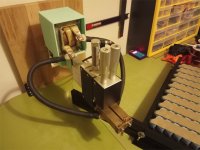


Got this modded spot welder for a year now.
The welding head has been removed from the body with the transformer and the control panel and an aluminum extension arm was milled to mount it on a table for huge pack depth.
* Wiring and hoses were extended along with 75mm2 cables going from the transformer to the welding head.
Until today it worked for a year perfectly and even changed the electrodes only once a few month ago.
Suddenly, with same nickel, same settings, same electrodes it sticks like crazy on 90% of the welds (welds are strong).
I tried sanding the tips (tried big flat and also pointy), replacing electrodes, changed electrodes angle a bit, same air pressure, lower power (of course) which just weakened the welds but still sticks, lower pulses (using 4), made the head press for a longer delay before firing, different nickels with and without slots (all 0.15mm pure nickel), different cells and NADA!
Something weird that I noticed with the machine that probably isn't related is that on strong electrode pressure and also with the head pressing for longer before firing the welds come out super weak which makes no sense to me.
What always worked for me was the head pressing the lightest the machine can (which is still a pressure you don't want you fingers getting caught in) and the touch is super brief.
Power on my machine is usually 300-350 (don't know what it means in current).
Pulse number is 4
Touch delay is 5
Would appreciate any help greatly!

